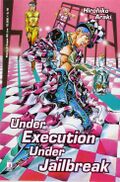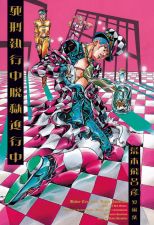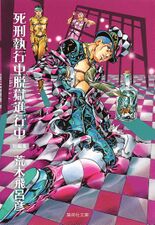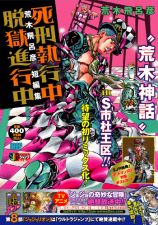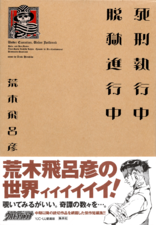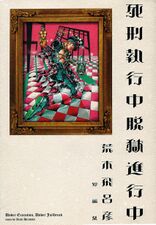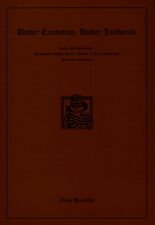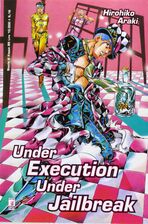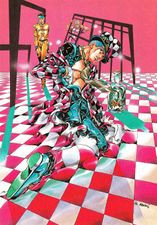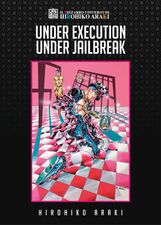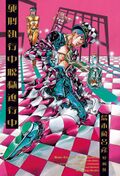
Under Execution, Under Jailbreak
Under Execution Under Jailbreak (死刑執行中脱獄進行中, Shikei Shikkōchū Datsugoku Shinkōchū) is a short story collection written and illustrated by Hirohiko Araki. The volume has seven chapters containing four unrelated stories.
A theatrical adaptation of the titular chapter, starring Japanese actor Mirai Moriyama, was performed in theaters across Japan from November to December 2015. The play was directed, composed, and choreographed by Nei Hasegawa.
An OVA adaptation of Thus Spoke Kishibe Rohan - Episode 16: At a Confessional by David Production was announced on August 18, 2019 and was released on Blu-ray and DVD on March 25, 2020.[1]
Summary
Under Execution Under Jailbreak is a one-shot chapter featuring a prisoner attempting to escape from a strange jail full of deadly traps. His jail cell is actually the execution room. After he is severely wounded, he discovers a hole in the wall, which is his only chance to escape. However, he is too scared to try going through it.
Dolce, and His Master is about a wrecked yacht in the midst of the ocean. A cat named Dolce and his master are the sole survivors. It has two chapters and was originally published in Allman magazine in 1996.
Deadman's Questions features Yoshikage Kira from Diamond Is Unbreakable who, despite having had his soul dragged to hell by the mysterious forces of the Ghost Girl's Alley, is still trapped on Earth, although now as a ghost without any of his memories from his prior life. It has three chapters and was originally published in Allman magazine in 1999.
Thus Spoke Kishibe Rohan - Episode 16: At a Confessional is the first chapter of the Thus Spoke Kishibe Rohan series, a JoJo's Bizarre Adventure spin-off starring Rohan Kishibe as the main protagonist. In this chapter, the mangaka hears a horror story from a mysterious sinner's confession. It was originally published in Weekly Shonen Jump in 1997.
Chapters
| Title | ISBN | |
|---|---|---|
| Chapters | Release Date | Cover |
| Under Execution Under Jailbreak (死刑執行中脱獄進行中 Shikei Shikkōchū Datsugoku Shinkōchū) |
978-4-08-619277-4 978-8-86-420690-5 | |
|
November 19, 1999[2] September 16, 2011[3]
|
|
Author's Note
The amount of effort it takes me to create a short story is about the same as me writing a longer one, the only difference being that the short story has to end after a few dozen pages. Even if I did have a good idea for a short story, I can't help but use it for my longer series because of that reason. The stories in this collection are examples of what happens when an unexpected friendship forms between an editor and a manga artist.
When the editorial department asked me to "write a short story", I was able to expand on an idea that I had left out of one of my longer series, an idea that made me think, "Well, I could use this for a short story." I can't help but think it was fate. In the twelve years that it took for this book to come out, that feeling has became more and more deeply ingrained in each of my works.なぜ自分は短編をあまり描かないのか?答えはアイデアを連載長編の方に使っちゃうからだ。長編の方には愛すぺき主人公がいるし、読者も短編よりは長編の方が魅力を感じてくれている。長編も短編もストーリーを0から作り上げていくのは同じ労力でも、短編は数十ページで終わりにしなくてはならない。だから、短編向きの良いアイデアがあってもつい長編の方に使ってしまう。
本書に集まった作品は、偶然に作られた編集者と漫画家の友情の結晶である。
「短編、描いてよ」
っていう編集部の依頼がきっかけで、長編からはみ出ていたアイデアを、「ンじゃ、これ短編に使おう」って感じでふくらましていくので、自分としては運命的なものを感じてしまう。そして、十二年に一冊という事で、ますますその思いが各作品に深く入っていってしまう。
『死刑執行中脱獄進行中』
(スーバージャンプ95年2号掲戴)
短編と長編の違いって、何なのだろうか?読者にとっては「そんなの、どうでもいいじゃん」って感じかもしれないけど、描く方にとっては違いを理解してないとヤバイ道に踏み込んでしまうかもしれない。ちょっと考えてみよう。どんな短編のタイプがあるのか?
A登場人物の行動や思いをひたすら追いまとめた作品。
Bほんの短い時間の出来事を切り取って、そこに人生やテーマを閃光のように象徴させる作品。
Cナンセンスやサスペンス、ムード、デザイン、エロ、グロ。それそのものを描くのを目的とした作品。
D日記やエッセイ、手紙。
他にあるかな?あとはABCDそれぞれの複合的作品。こう考えると、短編と長編の違いは? あんまり差はないように思える。
単に短い作品が短編で、長いのが長編。やっぱり、「どーでもいいじゃん」って結論に荒木飛呂彦も落ちついた。そーゆー理由で『死刑執行中脱獄進行中』は三十数ページという依頼ページで、死刑と脱獄を同時にさせるというアイデアから思いついた、ひたすらサスペンスを描くために描いたサスペンス。監獄が奇妙で、ここを作ったヤツら、姿は登場しないけど、不気味な存在がある所が好き。(作品タイプで言うとC)
『ドルチ ~ダイ・ハード・ザ・キャット~』
(オールマン96年11~12号掲戴)
ベージ数を限定されると、登場人物や物語の舞台も限定した方が話に迫力が出る。そーゆー発想から作り始めた作品。
この作品執筆時の担当編集者が、「猫が好きで好きでしょうがない。生活する上での心の希望なんだよ」
とまで言ったので、「でも、アンデスの山中で遭難したら、食べちゃうよ、きっと」と言ったイジ悪なわたしの性格が生み出した一編。(作品タイプはB)
『岸辺露伴は動かないーエピソード16:懺悔室ー』
(週刊少年ジャンプ97年30号掲戴)
子供の頃、父や祖父がよくわたしを叱る時、「無人島へ行け!おまえのようなヤツは!」とか、「刑務所に頼んで入れてもらうぞ!」(家の近所に刑務所があった)とか言われて、「無人島は行ってみたいなあ」と思ったが、「刑務所はすごく恐ろしくて、カンベンしてくれえ」と思った。そんな叱りの言葉の中に「普段、人をあざむいて生活していると一番幸福な時にバチがあたるぞ」というのがあって、それはいまだに恐ろしい。ハッピーって時に突き落とされるのが、ャパイって感じがあって、大人になるにしたがって恐怖の度合いが増して来てるんですけど。別に人をだましてはいないと思うんだけど、イヤな感じ。でも、それでもヘコたれない本作品の主人公は好き。タイトルの「動かない」というのは、岸辺露伴は主人公ではなく、物語のナピゲーターですよ、という意味。(作品タイプで言うとB)
『デッドマンズQ』
(オールマン99年12~14号掲戴)
死んだあとも心の平和を願って、精神的に生長していこうとする主人公の行動を、スケッチ風に描いた作品。(作品タイプでA) 主人公のデッドマンは『ジョジョの奇妙な冒険第4 部』の最大の敵•吉良吉影という、死んだ殺人鬼である。
死後の世界、もし魂が残っているのなら、それは何でもありの世界ではなく、この世と同じ『ルール』があるはずだ。幽霊も生きてる時と同じか、それ以上に苦労しなくてはおかしい……という発想で描いた。それにしても、好きな音楽を楽しめない彼を描いてて、何か涙が出て来た。